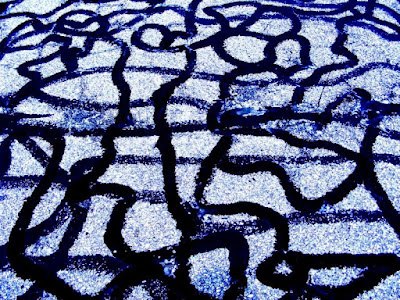Above is a late painting by Willem de Kooning. Setting aside the debate about whether, because of his advancing Alzheimer's, he really knew what he was making, the big looping linearity of his late style is unmistakable.
Now look at what I saw in the car park of a shopping mall just off I-90 in north-western New York State, where Patty and I stopped for some grub on our drive back from Maine:
Over time they had made so many repairs to the cracks in the tarmac that they accidentally created an homage to Willem de Kooning. Judging by the way people were looking at me, and nearly driving over me, as I knelt on the blistering surface and took photographs of the 'pavement' they were driving on, these observations hadn't really occurred to anyone else on their way to pick up fast food or to buy sweatshop jeans.
 Subscribe to Praeterita in a reader
Subscribe to Praeterita in a reader
Now look at what I saw in the car park of a shopping mall just off I-90 in north-western New York State, where Patty and I stopped for some grub on our drive back from Maine:
Over time they had made so many repairs to the cracks in the tarmac that they accidentally created an homage to Willem de Kooning. Judging by the way people were looking at me, and nearly driving over me, as I knelt on the blistering surface and took photographs of the 'pavement' they were driving on, these observations hadn't really occurred to anyone else on their way to pick up fast food or to buy sweatshop jeans.


